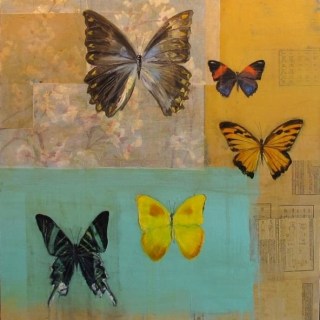
TOM JUDD
THE MYTH OF THE FRONTIER
November 16 – December 19, 2015
NEW YORK, November 3, 2015 - William Holman Gallery is honored to present our third solo exhibition of new work by Tom Judd at the gallery from November 16 to December 19, 2015. A lifelong interpreter of memory and of the allegory of modern life, Judd has focused this new work on our interpretations and misconceptions about the American West, where he grew up – in Salt Lake City, during the 1950’s. The exhibition includes 15 new works including a multi-media installation, paintings and collages related to his interpretation of The Myth of the Frontier. In his own words Tom Judd has addressed his intent in this new work.
This is the Place
I grew up in Salt Lake City, in the heart of what I’m calling the “Myth of the Frontier.” Entangled with the Mormon religion, the settling of the Salt Lake Valley was considered nothing short of God’s plan. Brigham Young was said to have uttered aloud, upon seeing the valley for the first time, “This is the place.” This is in keeping with the very American notion of Manifest Destiny (the belief that it was Anglo-Saxon Americans’ providential mission to expand their civilization and institutions across the breadth of North America).
Mount Rushmore is the most ambitious and exaggerated expression of this vision.
The Invented Myth
David Hamilton Murdoch, a British historian, wrote a terrific book, The American West: The Invention of a Myth about the strange obsession Americans have always had with the conquest and settling of the western territories. Ronald Reagan personified this story telling and its perceived consequences…
“If we understand this part of our history, we will better understand how our people see themselves and the hopes they have for America.”
Reagan goes on to present the following western celebrities as the embodiment of our national character - Wild Bill Hickok, Calamity Jane and Annie Oakley - are examples of “ideals of courageous and self-reliant heroes, both men and women, (who) are the stuff of Western lore…(whose) integrity, morality, and democratic values are the resounding themes.”
The real story, as history relates the facts, is not ideal:
- James Butler Hickok was a cold-blooded killer who spent most of his time gambling and chasing prostitutes.
- Martha ‘Calamity Jane’ Canary was a sad transvestite alcoholic, an inveterate liar who was reduced to exhibiting herself as a sideshow freak.
- Phoebe Anne Oakley (Mozee) was entirely the creation of show business; the tiny feisty woman, a great pistol trick-shot was born in Ohio and had never been in the West until she joined Buffalo Bill Cody’s Wild West Show.
Coonskin Hats
Then there are Lewis and Clark, Daniel Boone, and of course the pioneer Davy Crockett. Crockett became personified in our minds by the character actor Fess Parker, the handsome star of the TV series. Parker had a soft spoken stoicism about him that had little resemblance to the real David Crockett who by the way did not appreciate being called Davy. Yet this Hollywood mythology permeates our culture and blurs the line between what really happened and what we want to believe. You could say the “Myth” lives on in the psyche of the American people to this day, manifested in everything from our politics, to our architecture, our attitudes towards the rest of the world, and our core values.
Marlboro Country
From the dime store novels to Hollywood, from Madison Avenue advertising to the White House, we see the impact of the “Myth.” For example, the “Marlboro Man”, alone with his horse in the vast western landscape; independent, sometimes courageous, selling us the ruggedness of cigarettes, a known carcinogen. This kind of toxic absurdity epitomizes the myth making associations that we hold true and close to our heart as post World War II Americans. While none of these images area appropriated from advertising as in the work of Richard Prince, the thought of how our invented history and TV influences our lives is always close at hand. This exhibit also speaks to my love of the epic American landscape, which is the background of this invention of myth. I too love the “Myth” itself as long as it stays a myth and is not sold to us as the truth.
Tom Judd:
Raised in Salt Lake City, Utah, Tom Judd now lives and works in Philadelphia. The great-grandchild of the famous Mormon Church president (1918-45) Heber J. Grant, Judd is not an active church member, but remains deeply informed by the landscape of his youth in Utah and the West. His work is in the collection of the Philadelphia Museum of Art, the Philadelphia Academy of Art and in numerous university and private collections. Judd has been the recipient of the Tandem Press Fellowship Residency, the Millay Colony Fellowship, the MacDowell Colony Fellowship and the Pollock Krasner Grant. Tom Judd lives and works in Philadelphia
For more information on the gallery’s exhibition schedule, images, and a catalogue to the exhibition please visit http://www.wholmangallery.com/exhibitions/.
###







































